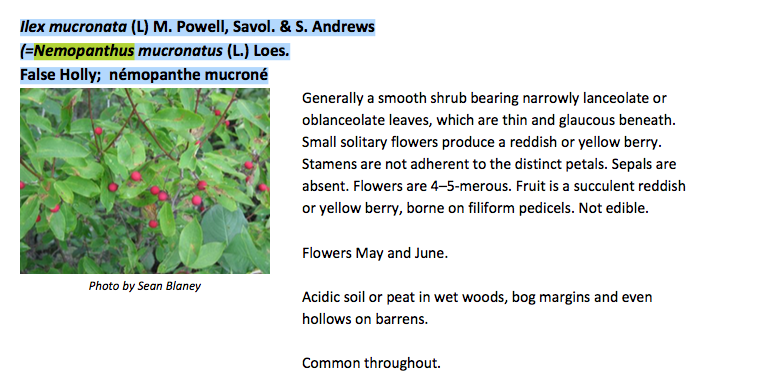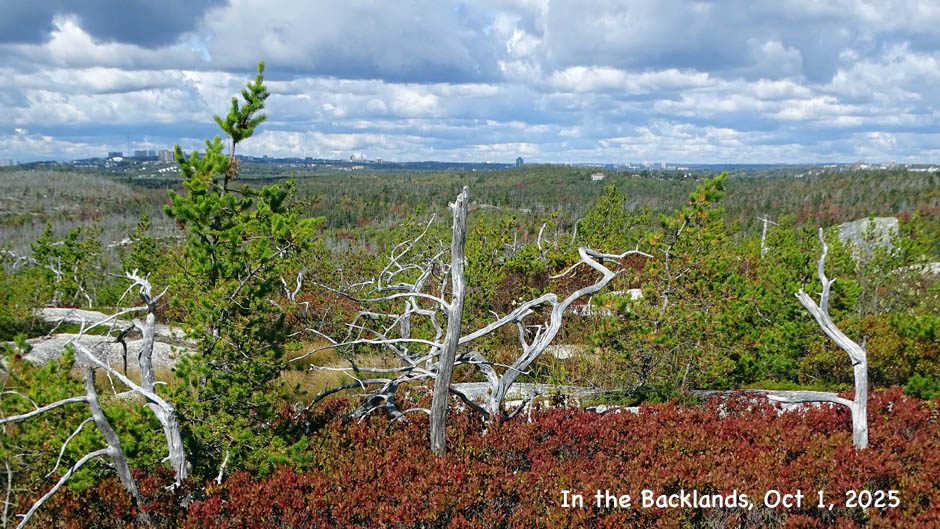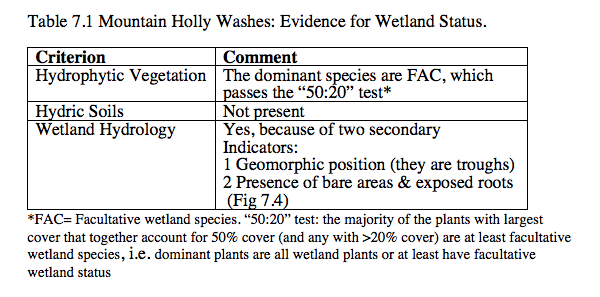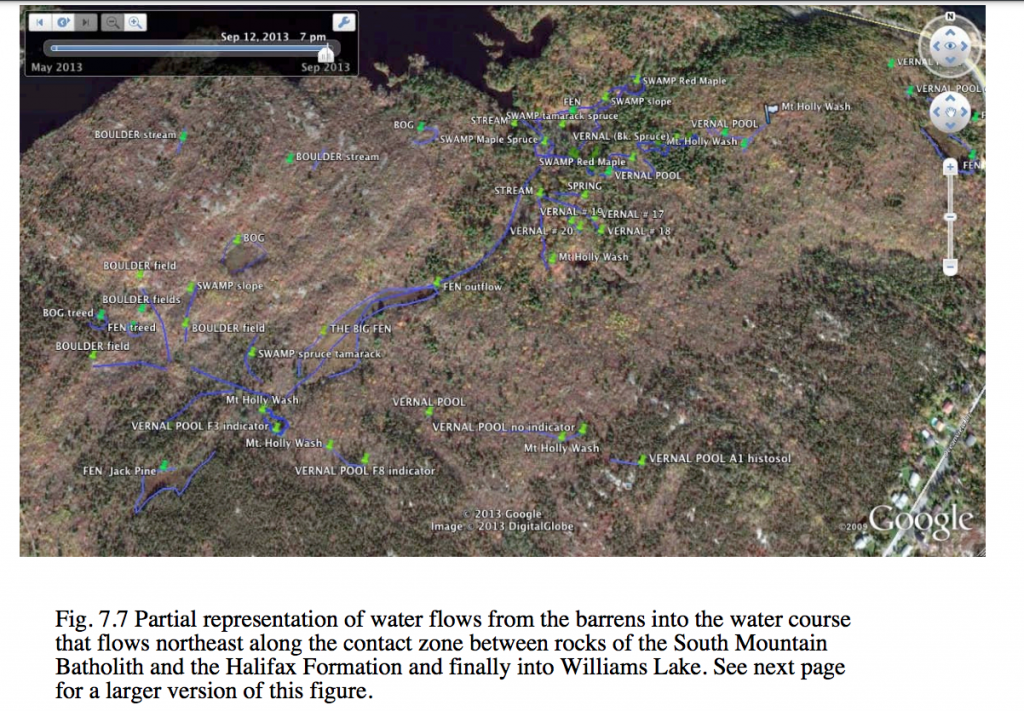By David Patriquin, May 2021
Mountain Holly (Ilex mucronatus; false holly, catberry) is a common shrub in the backlands at the edges of wetlands, and in seasonal watercourses in the uplands on the Backlands. NS wetland authority Nick Hill considers them to be the signature species and marker of “washes” which are infiltration channels or intermittent streams found in the Backlands. Says Hill: “Despite the essential role of these ephemeral and intermittent streams in the WLB [Williams Lake Backlands] in channeling and infiltrating water and delivering it to Vernal Pools nodes that form where the slope of Washes levels off, these stream courses have no official protection.” Read more below

Mountain Holly Plant with male flowers. Herring Cove Backlands, May 31, 2007.SOURCE: JackPine on NSWFS
| Aquifoliaceae: Ilex mucronatus (L.) M. Powell, Savol., & S. Andrews (false holly, mountain holly, catberry) This sometimes very large shrub is common thoughout Nova Scotia in damp, acid habitats. It has alternately borne, simple (undivided), thin leaves with smooth or finely toothed margins. Small whitish to yellow-green flowers on long pedicels appear in mid spring, male and female flowers on separate plants. The fruit is a deep red drupe. The species is native to eastern North America. |
View pics of habit at GoBotany & NS Wild Flora Society
Screen capture From Nova Scotia Plants (Munro, Newell and Hill, 2014):

Wetland Status
Mountain Holly (Ilex mucronata, syn Nemopanthus mucronata) is considered an Obligate wetland species in most areas, e.g. the U.S. Fish and Wildlife Service (Reed 1988) classifies it as an Obligate wetland Indicator species. However for NS it is considered a Facultative Wetland Indicator (see NSE Wetland Indicator Plant List)
From Reed 1988:
INDICATOR CATEGORIES
Obligate Wetland (OBL). Occur almost always (estimated probability >99%) under natural conditions in wetlands.
Facultative Wetland (FACW). Usually occur in wetlands (estimated probability 67%-99%), but occasionally found in nonwetlands.
Facultative (FAC). Equally likely to occur in wetlands or nonwetlands
(estimated probability 34%-66%).
Facultative Upland (FACU). Usually occur in nonwetlands (estimated probability 67%-99%), but occasionally found in wetlands (estimated probability 1%-33%).
Obligate Upland lUPU. Occur in wetlands in another region, but occur almost always (estimated probability >99%) under natural conditions in nonwetlands in the region specified. If a species does not occur in wetlands in any region, it is not on the National List.The wetland Indicator categories should not be equated to degrees of wetness. Many obligate wetland species occur in permanently or semipermanently flooded wetlands, but a number of obligates also occur and some are restricted to wetlands which are only temporarily or seasonally flooded. The facultative upland species include a diverse collection of plants which range from weedy species adapted to exist in a number of environmentally stressful or disturbed sites (including wetlands) to species in which a portion of the gene pool (an ecotype) always occurs in wetlands. Both the weedy and ecotype representatives of the facultative upland category occur in seasonally and semipermanently flooded wetlands.
From: Ralph W. Tiner. 10 Nov 2016, Plant Indicators of Wetlands and Their Characteristic
from: Wetland Indicators, A Guide to Wetland Formation, Identification, Delineation, Classification, and Mapping CRC Press Accessed on: 31 May 2021:
Plant Specificity
While a couple of thousand species grow exclusively in U.S. wetlands, thousands of others are more wide-ranging. Some of the latter occur mostly but not always in wetlands, whereas others display no particular affinity for wetlands and still others are actually more common in uplands. When the plants are growing under wetland hydrologic conditions, they are hydrophytes regardless of where the majority of individuals of their species occur. The best plant indicators of wetland are clearly those species with the highest affinity for wetlands (see Table 3.3 for common examples).
The affinity of certain species may vary with latitude or, in mountainous areas, with altitude. For example, in the Northeast, Labrador tea (Ledum groenlandicum) is restricted to wetlands, mainly bogs. Yet in Labrador and Newfoundland, this species also occurs in dry heaths and woods (Ryan, 1989). Mountain holly (Nemopanthus mucronata), an exclusive wetland species in most of its U.S. range, occurs in uplands and wetlands in coastal eastern Maine. Presumably the combination of low evapotranspiration, cold climate, moderate frequency of fogs, and cool, moist air (maritime influence) creates favorable conditions on drier soils. The colder climates, especially along the coast, may permit some excellent wetland indicator plants to be less reliable indicators locally
From: Ecological Assessment of the Plant Communities of the Williams Lake Backlands
A REPORT to The Williams Lake Conservation Company. N. Hill and D. Patriquin. 2014.
Mountain Holly intermittent streams or “Washes”
In the WLB, there is a network of Mountain Holly Washes, or infiltration channels, that are trough depressions down slopes between the exposed ridge and rocks, and the swamps at lower elevation.
Mountain Holly (Nemopanthus mucronata) is the signature species and marker of these washes. Mountain Holly has been listed as a Facultative Wetland (FAC) species by Nova Scotia (Blaney, 2011) however, it is recognized as an Obligate (OBL) wetland plant in listings (Lichvar, 2013). It is a tall shrub with slow twisting growth and red barked roots that go deep to wet sediments in these washes; the plant takes two years to germinate and its seedlings occur in washes where leaf litter has been removed by runoff (Fig 7.6).
Mountain Holly marks these wash channels and often co-occurs with Red Maple. The inside wash typically has a shallow peat layer and a mix of sand and fines (silt & clay), the wash channel is lined by a small boulder transition zone outside of which is a HUCKLEBERRY (FAC in NS, FACU = Facultative Upland in US) shrub savannah with birch (Paper or Wire) or Jack Pine.
Washes can be described as infiltration channels or intermittent streams. In dryland regions, larger intermittent streams are called arroyos or gullies and in some US states they are afforded the protection of perennial stream courses, e.g., see New Mexico Wetland Regulations (n.d.) because they account for the majority (e.g. 80%) of the water flow channels in these regions (Levink et al., 2008). Headwater, first order streams can also account for 60% of the total volume of flow of watersheds in the northeast (Alexander et al., 2007) and it has been estimated that such streams have been underestimated in 80% of cases (Brooks and Colburn, 2011).
Flows from ephemeral and intermittent streams drive hydrological regimes in small watersheds such as the Williams Lake Backlands. Mountain Holly and Red Maple canopies of the washes shade and cool the water that flows through them; a part of this overland flow infiltrates in these Washes but a larger portion flows through the channels and infiltrates at Vernal Pool nodes that occur throughout this network of washes wherever slope levels off. Altogether, this system delays and slows water flow, it also shades and cools water, infiltrating a portion and delivering the remainder to vernal pool nodes at intermediate rainfall intensities or the overflow to swamps. Run-off in the Backlands is driven by topography and glacial history, by the ridges and rocky slopes that have little fine glacial till, and the hydrology of the small watersheds functions in the same manner as a dryland area although the climate is quite different. At the Backlands, run-off initially speeds into Mountain Holly Washes, it temporarily fills vernal pool nodes, and then overflows into lower elevation washes, their vernal pools, and finally and into the swamps just above Williams Lake.
Despite the essential role of these ephemeral and intermittent streams in the WLB in channeling and infiltrating water and delivering it to Vernal Pools nodes that form where the slope of Washes levels off, these stream courses have no official protection. To promote infiltration to avoid flooding and stormwater backup, such courses are designed into urban designs and are termed “Swales”.
Swales and Washes alike may or may not conform to the requirements for designating wetland:
Read more about the significance of Mt. Holly washes in pp 58-73 of Ecological Assessment of the Plant Communities of the Williams Lake Backlands; also pages 77 & 78 on The Case for Conservation: (ii) The Wetland/Watercourse Complex.




